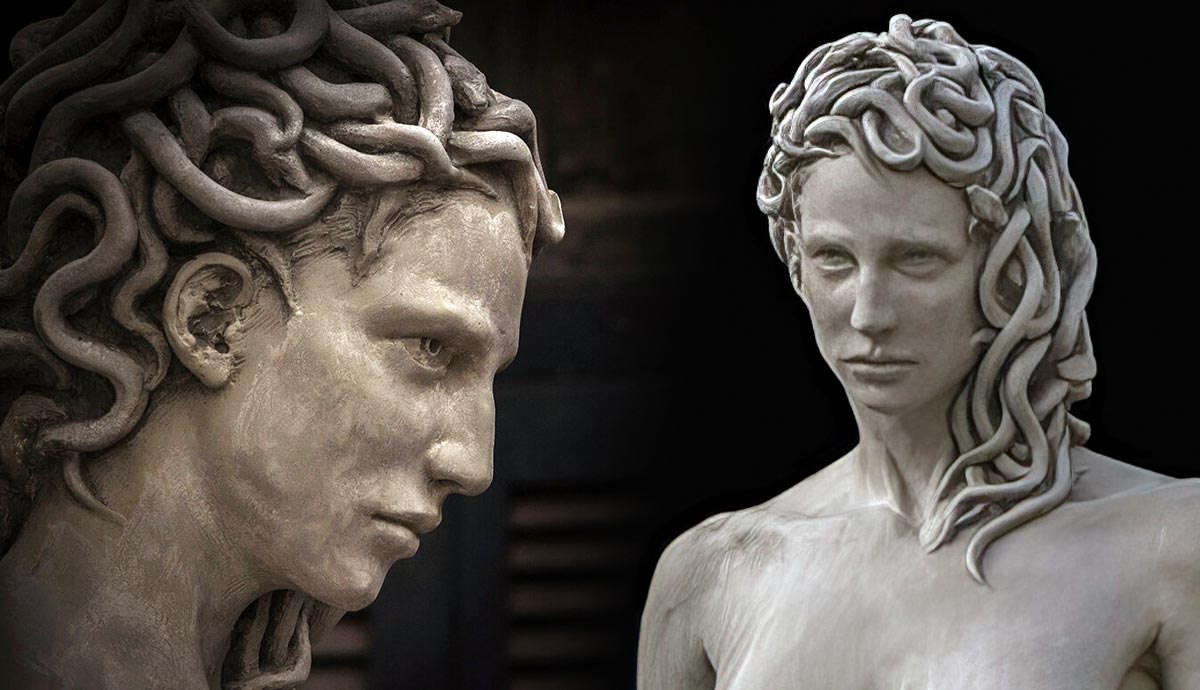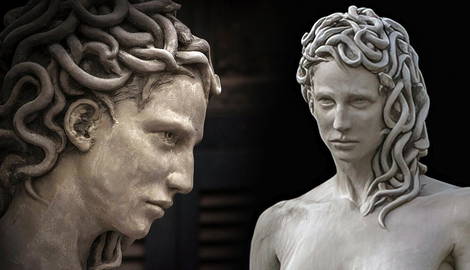
The myth of Medusa served as an inspiration to numerous artists throughout history. Different artistic approaches aside, what all these artists had in common was the vilification of Medusa. She was a monster righteously beheaded by Perseus. Therefore, the artwork of Argentinean artist Luciano Garbati, Medusa with the Head of Perseus, offered a refreshing alternative. Empowering Medusa, he represented her as the victor rather than the victim. This innovative reimagining of established mythological tropes contributed to ongoing conversations on feminism and gender.
The Myth of Medusa

Like many other myths, the myth of Medusa also comes in numerous versions. The most well-known and referred to by visual artists is the one that Ovid, a great poet of ancient times, gave in his capital work Metamorphosis. Namely, Medusa was one of the three Gorgons and the only mortal one. Famous for her beauty, she attracted male attention. She didn’t respond to any of those pursuits, since she vowed her virginity to Athena, the goddess of wisdom and warfare, by becoming her priestess. However, Poseidon, the god of the sea, couldn’t resist her charms, so he raped her in the temple. Athena, outraged at this blasphemous deed that desecrated her temple, decided to punish Medusa. She took away her beauty and turned her into a snake-haired monster with a petrifying gaze that could kill anyone who looked her in the eyes.

Polydectes, king of Seriphos, fell in love with Danae who was Perseus’s mother. Since Perseus was overly protective of his mother, he posed a threat to the king’s pursuit. Consequently, Polydectes decided to eliminate Perseus by commanding him to do the impossible—obtain the head of Medusa as a gift to him. To Perseus’s advantage, he received help from Athena who advised him to put a mirror on his shield, so he could behead Medusa without having to look at her directly. After successfully accomplishing the task, Perseus learned that Medusa’s head had preserved her power, so he began to use it against his enemies. In the end, he gave it to Athena who put it on her own shield for apotropaic and prophylactic purposes.
The Artwork That Provided Inspiration for Garbati’s Sculpture

Luciano Garbati is an Argentinean artist of Italian descent born in Buenos Aires in 1973. He began his artistic education in Argentina, but in 2001 he earned a scholarship and moved to Rome. Garbati became infatuated with the Italian Renaissance, Mannerism, and Baroque. Perseus with the head of Medusa, the artwork of a 16th-century Renaissance and Mannerist sculptor Benvenuto Cellini, especially captured his heart. Having spent time in Italy, Garbati had the privilege of admiring its beauty as well as Cellini’s talent and craftsmanship in person. What’s fascinating about this sculpture is that Cellini succeeded in casting the entire statue from a single piece of bronze, which was something rarely done.

However, Garbati started to wonder why Western civilization produced only art that positioned Medusa as the villain and the culprit. The manner in which Cellini approached the myth is phallocentric and one-dimensional. Depicted as a hero, Perseus gloriously holds the gorily decapitated head of Medusa while standing on her blood-gushing body. As with most artworks of the time, Perseus with the Head of Medusa has its background in politics. Cosimo I de’ Medici, the Duke of Florence and an artistic patron, commissioned this sculpture in 1545 to represent his political power. Perseus, as a masculine symbol of power and virility, was chosen to personify the control of the Medici over the Florentine people who were in turn portrayed by Medusa, a sinful and bloodthirsty female. This dichotomy between the male hero and the female villain, omnipresent in the myth of Medusa, inspired Luciano Garbati to make a reactionary version of the work. He envisioned a piece where he could reinterpret the myth and give Medusa a chance to take an active role by questioning culturally imposed gender roles.
Medusa with the Head of Perseus

Luciano Garbati made his piece Medusa with the Head of Perseus using clay and cast it in resin with fiberglass reinforcements. Over 6 feet tall, this artwork materializes Garbati’s answer to Cellini’s sculpture. The roles are completely reversed here. Now, Medusa is the one who comes out as the winner from her encounter with Perseus. However, her posture seems everything but victorious. While Cellini’s Perseus had a very triumphant pose, Garbati’s Medusa is resolute in completing a task that was imposed on her.
Attacked, Garbati’s Medusa decided to fight back and defend herself. Thus, Garbati finally changed the archaic narrative of Medusa as the monstrous enemy that deserved to be slaughtered. Here, Medusa has an active role which gives her newfound strength and empowerment.
Her facial expression is also very telling. Unlike Cellini’s Perseus who seems content and composed, Garbati’s Medusa looks tired of constantly being mishandled. Nevertheless, there is a strong determination in her eyes proving that she is ready to protect herself from any further attacks. Finally, an interesting point to note is the fact that Garbati modeled the beheaded Perseus after himself and his own facial features. Conversely, Cellini inserted his self-portrait on the back of Perseus’s helmet.

All things considered, it becomes obvious how Garbati’s sculpture reshapes the established understanding of gender roles. The patriarchal values of masculine righteousness are overthrown and discarded. Now the woman holds all the power. Medusa brought patriarchy to justice by having the story told from her perspective. Raped by Poseidon, scorned by Athena, and attacked by Perseus, Medusa has been silenced up until Luciano Garbati made his artwork.
Recognition From the #MeToo Movement

The #MeToo movement is a social movement and awareness campaign founded in 2006 by Tarana Burke, a New York activist. The goal of this movement is to empower and show compassion to abused people by encouraging them to publicize their stories of sexual abuse and sexual harassment. #MeToo reached its peak in 2017 when a significant number of women in the entertainment industry accused Harvey Weinstein, a film producer, of sexual abuse and assault.
A full decade after it was created, Garbati’s sculpture was recognized by numerous participants and supporters of the #MeToo movement as symbolic. Thanks to the internet, Medusa with the Head of Perseus went viral on social media and became a symbol of female rage. Even though Medusa was raped, she was identified as the guilty party. This kind of scenario is very common in modern society as well.

A New York-based photographer Bek Andersen also recognized the potential of Luciano Garbati’s sculpture. At her initiative, Garbati made a bronze replica of his sculpture in 2018. It was then placed in front of the New York County Criminal Court building where sexual offenders were being prosecuted.
Controversies Surrounding the Garbati’s Sculpture

Luciano Garbati’s artwork didn’t slip by without attracting some negative reactions and criticism. Certain critics had trouble with the artist’s gender. Since Garbati is male, he is presumably not suitable to address topics such as marginalization and discrimination of women. His nude, beautiful, and sexually attractive Medusa is modeled after contemporary beauty standards. Therefore, many detected the underlying notion of the male gaze in Garbati’s artwork.
Furthermore, by choosing a White Medusa to be a symbol of sexual abuse survivors, other groups felt discriminated against. Therefore, it isn’t very helpful to make a correlation between a White female victim and a whole movement, such as #MeToo, which was supposed to be inclusive and all-embracing. Also, women are not the only victims of sexual violence. Men, children, and nonbinary people can also be ones.
Finally, the way in which Medusa is empowered in Garbati’s work was also severely criticized by some #MeToo supporters. Medusa was able to regain her strength by adopting a male tool of power—Perseus’s sword. In order to defend herself, she had to employ aggression and violence, all representatives of male values. The #MeToo movement founder Tarana Burke expressed her disapproval, pointing out that the movement is supposed to be based on healing and action, not violence and revenge.
Some even share the opinion that the myth of Medusa didn’t need any additional interventions, since Medusa was already seen as a symbol of female power. Her ability to turn men into stone was often interpreted as an allegory. By petrifying men, she could use the male gaze against men and thus protect herself from further abuse.
Why is Garbati’s Reinvention of Medusa Important?

Luciano Garbati’s Medusa confirmed that myths are still a part of our collective subconscious. Whether positive or negative, his sculpture provoked strong reactions on a global level. By reimagining Medusa’s story, Garbati deconstructed gender stereotypes that have been perpetuated through such myths. His sculpture transformed the notion of women as passive victims.
On the other hand, his sexualized portrayal of Medusa as a beautiful White woman provoked marginalized and discriminated groups to speak out and let their voices be heard. African Americans and Indigenous peoples protested that they couldn’t relate to this kind of image. Garbati’s Medusa was approachable and welcoming only to a part of the population, which had already been privileged and socially advantaged. Therefore, the main criticism was that his sculpture wasn’t inclusive and in turn noteworthy. One thing is for certain—by reinterpreting the myth of Medusa, Garbati contributed to a broader social dialogue on gender roles and gender norms. Regardless of whether one assumes an affirmative or critical stance, it is undeniable that Garbati’s sculpture induced a collective response and provoked increased engagement from feminists, activists, and women in general.










